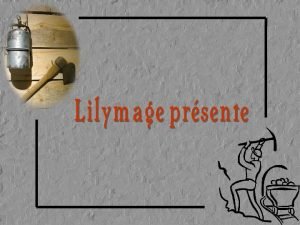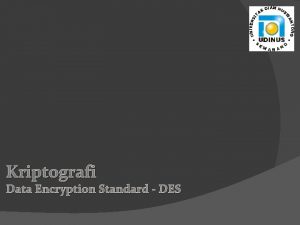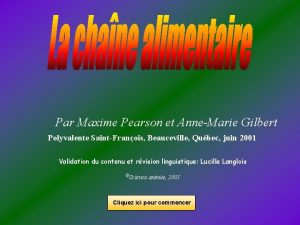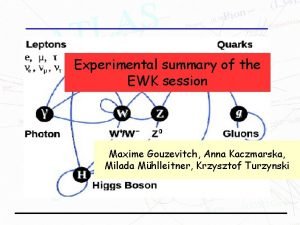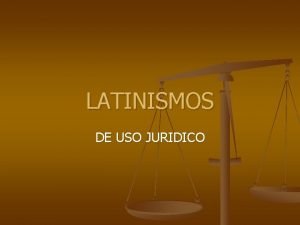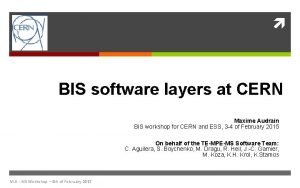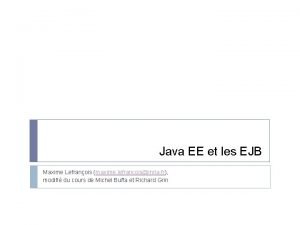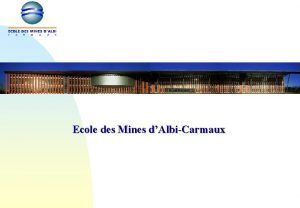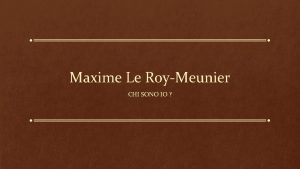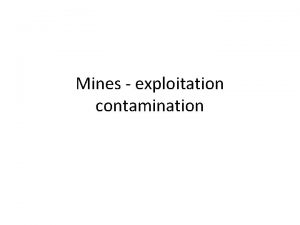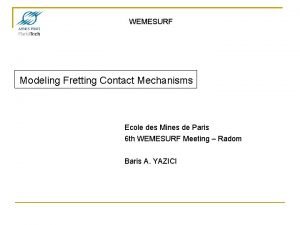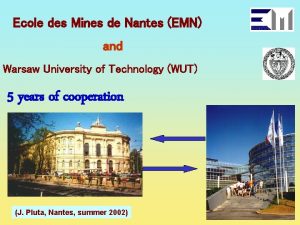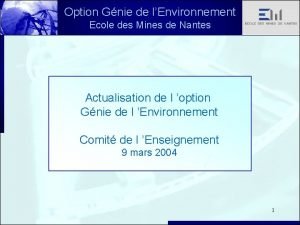Conceptual Graphs Maxime Lefranois Ecole des Mines de












- Slides: 12

Conceptual Graphs Maxime Lefrançois Ecole des Mines de Saint-Etienne 1

Conceptual graphs (John F. Sowa, 1979) A graph-based representation formalism that is very expressive Recipe: my. Mum. Omelette 1 has. Ingredient 2 Ingredient: four. Eggs 2 Human: Mum 1 3 cook Recipe. Realization: o 475 1 parent. Of 2 2 Human: Me 1 eat 2

Conceptual graphs (John F. Sowa, 1979) Concept node Alternance concept node / relation node Recipe: my. Mum. Omelette 1 Name of class has. Ingredient 2 Ingredient: four. Eggs Name of instance 2 Human: Mum 1 3 cook Recipe. Realization: o 475 1 parent. Of 2 2 Human: Me 1 eat Relation node Name of the relation Index of the argument of the relation Human(Mum) ∧ Human(Me) ∧ parent. Of(Mum, Me) 3

Conceptual graphs (John F. Sowa, 1979) Classes and Relation Hierarchies Recipe Animal is. Composed. Of Human Female Vegan. Recipe has. Ingredient Lady Class hierarchy binary relations hierarchy ternary relations hierarchy 4 …

Conceptual graphs (John F. Sowa, 1979) Existential quantifier : my. Mum. Omelette 2 : Mum 1 3 cook Recipe. Realization: 2 Human: 1 eat There exists a realization of my. Mum. Omelette that Mum cooked, and there exists some Human that eat this omelette (∃x, y) [ cook(Mum, my. Mum. Omelette, x ) ∧ Recipe. Realization(x) ∧ Human(y) ∧ eat(y, x) ] 5

Conceptual graphs (John F. Sowa, 1979) Negation operator : my. Mum. Omelette Cooccurrence relation (same instance) 2 : Mum 1 cook 3 Recipe. Realization: o 475 Scope of the negation ¬ : Me 1 eat 2 : o 475 is a realization of my. Mum. Omelette that Mum cooked. Me do not eat o 475 cook(Mum, my. Mum. Omelette, o 475 ) ∧ ¬ [ eat(Me, o 475) ] 6

Conceptual graphs (John F. Sowa, 1979) Negation operator and conjunction disjunction ¬ : Me : Mum 1 eat 2 : o 475 2 It is not true that [ Me eat o 475 and Mum eat o 475 ]. ¬ [eat(Me, o 475) ∧ eat(Mum, o 475) ] ⇔ ¬ eat(Me, o 475) ∨ ¬ eat(Mum, o 475) 7

Conceptual graphs (John F. Sowa, 1979) Negation operator and existential quantifier universal quantifier : my. Mum. Omelette 2 : Mum 1 cook 3 Recipe. Realization: o 475 ¬ : 1 eat 2 : o 475 is a realization of my. Mum. Omelette that Mum cooked, and it is not true that [ there exists someone that eat o 475] cook(Mum, my. Mum. Omelette, o 475) ∧ Recipe. Realization(o 475) ∧ ¬ [ (∃x) [ eat(x, o 475) ] ] ⇔ cook(Mum, my. Mum. Omelette, o 475) ∧ Recipe. Realization(o 475) ∧ (∀x) ¬ eat(x, o 475) ⇔ (∀x) cook(Mum, my. Mum. Omelette, o 475) ∧ Recipe. Realization(o 475) ∧ ¬ eat(x, o 475) 8

Conceptual graphs (John F. Sowa, 1979) Rules : my. Mum. Omelette 2 1 : ? x cook Sad: ? x 3 : ? y ¬ : 1 eat 2 Hypothesis : ? y ⇒ 1 throw 2 : ? y Conclusion Approximative translation: If no one eat a omelette, then the one who did it has to throw it, and he belongs to the class of Sad people 9

Conceptual graphs (John F. Sowa, 1979) Homomorphism from H to G = G is a specialization of H Recipie: 2 Human: 1 cook Vegan. Recipie: 3 : cook 3 : 2 1 1 relative. Of Human: Mom 2 1 2 : eat parent. Of 2 1 Human: Me G H Specialization of concept nodes (class, instance), Specialization of relation nodes (name of the relation), Potentially new concept and relation nodes 10

Conceptual graphs (John F. Sowa, 1979) Use rules to deduce new knowledge: If a graph G specializes the hypothesis H of a rule R=<H, C>, then R is applicable. One can then apply R by adding C to G. in general, checking the conceptual graphs homomorphism is NP-Complete Given a set of rules and a conceptual graph G (starting point), one can saturate G by applying all the applicable untill none of the rules are applicable anymore. may never end… Given a set of rules, a conceptual graph G, and a conceptual graph Q (query), One can deduce Q from G, if there is a sequence of rule application that transform G into a graph G’ that specializes Q. finding this sequence automatically is sometimes complex… there algorithms that implement strategies (forward chaining, backward chaining, hybrid)… there are tests that one can do on a set of rules to prove the complexity of deduction… 11

Conceptual graphs (John F. Sowa, 1979) More about conceptual graphs Graph-based Knowledge Representation, Computational Foundations of Conceptual Graphs Michel Chein, Marie-Laure Mugnier, Springer, 2009, 428 p. (partly available online) 12
 Hotel des mines faymoreau
Hotel des mines faymoreau Des des des
Des des des Les limites de l'école des relations humaines pdf
Les limites de l'école des relations humaines pdf Speed and velocity
Speed and velocity Graphs that enlighten and graphs that deceive
Graphs that enlighten and graphs that deceive Which two graphs are graphs of polynomial functions?
Which two graphs are graphs of polynomial functions? Zczc state graph
Zczc state graph Maxime tremblay notaire
Maxime tremblay notaire Maxime bergeret
Maxime bergeret Maxime pearson
Maxime pearson Bosonar caral
Bosonar caral Corpus deliti
Corpus deliti Maxime audrain
Maxime audrain
